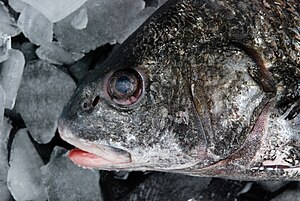Black drummer
| Black drummer | ||||||||||||
|---|---|---|---|---|---|---|---|---|---|---|---|---|

Black Drummer ( Pogonias cromis ) |
||||||||||||
| Systematics | ||||||||||||
|
||||||||||||
| Scientific name of the genus | ||||||||||||
| Pogonias | ||||||||||||
| Lacépède , 1801 | ||||||||||||
| Scientific name of the species | ||||||||||||
| Pogonias cromis | ||||||||||||
| ( Linnaeus , 1766) | ||||||||||||
The black drummer or bearded umber ( Pogonias cromis ) is a species of fish from the ( monotypical ) genus Pogonias in the umber family (Sciaenidae).
features
The specialty of its kind are numerous, quite rigid barbels on the lower edge of the lower jaw (pogonias, Greek: "the bearded"), barbels are generally rare in Perciformes . The species name cromis does not have to be a misspelling of chromis (χρόμις), which means in antiquity a (probably Umber) fish that is no longer clearly recognizable, but can be based on a vernacular name ; it had and has nothing to do with χρῶμα (color) ( in the 19th century, chromis is used to describe very different fish, e.g. cichlids , but now a genus of the Pomacentridae ).
But the bearded umber is famous for its melodic drum choirs, which Alexander von Humboldt experienced and described (initially without a clue what it was about) on February 20, 1803 in the mouth of the Magdalene Current (although other species were also involved to like). The tones, generated by its swim bladder with very complex structured appendages and perceived by large otoliths as a hearing sense , serve to bring the sexes together at spawning time in spring. Eggs and larvae then develop in open water.
The drummer can live to be 1.7 m long, weigh over 50 kg and over 40 years old. Its coloring is essentially a dark (Prussian) blue or gray; Young fish are silvery with 6–8 dark transverse bands. For a Sciaenid, Pogonias has large scales, about 50 on the sidelines .
Tail formula : D1 XI, D2 I / 19-22 or D XII / 19-22, A II / 5-7.
Occurrence and way of life
The Black Drummer lives on the west Atlantic coasts from Nova Scotia to the Caribbean and Central Argentina. In the tropical area it is rarer in places. It lives in sandy bays, especially near river mouths, which it also penetrates, as well as seagrass areas. Most of the time it lives sociable, sometimes it forms large schools that can advance into the open water.
The food consists of worms and mollusks (he has pharyngeal pinch teeth), later also from algae, shrimp and crabs, and then there are also smaller fish. He swims slowly to the bottom and feels (and “tastes”) with his “beard” for creatures hidden in the sand. If he notices any, he stands up steeply (similar to a carp) and digs or blows the animal free, creating a small funnel that also reveals his presence to fishermen.
Use and endangerment
The black drummer is economically important, e.g. B. in the Gulf of Mexico . As a "sport fish", however, he is hardly an option. Due to overfishing due to its size and the accumulations for spawning, habitat loss and habitat degradation as well as environmental pollution and the bycatch of juvenile fish, the black drumstick is threatened, the stocks are decreasing. In its southern area of distribution (Brazil, Uruguay, Argentina) it is already considered endangered or endangered, but due to its large distribution area and the large populations in some places it is classified as not endangered by the IUCN (LC, Least Concern).
Individual evidence
- ↑ Fishbase
- ↑ a b IUCN
- ^ HB Bigelow, WC Schroeder: The Fishes of the Gulf of Maine , 1953 (revision 2002).
literature
- CR Robins, GC Ray: A field guide to Atlantic coast fishes of North America. Houghton Mifflin Company, Boston 1986
Web links
- Black Drummer on Fishbase.org (English)
- Pogonias cromis inthe IUCN 2017-3 Red List of Threatened Species . Posted by: L. Chao, JP Vieira, M. Brick Peres, M. Haimovici, 2015. Retrieved December 25, 2017.